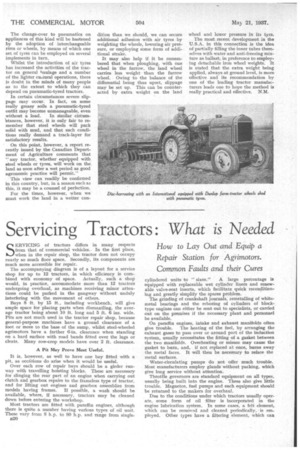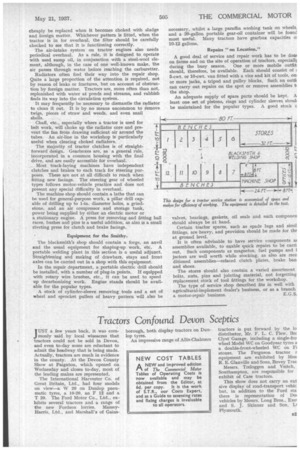Servicing Tractors: What is Needed S ERVICING of tractors differs in
Page 54

Page 55

If you've noticed an error in this article please click here to report it so we can fix it.
many respects from that of commercial vehicles. In the first place, when in the repair shop, the tractor does not occupy nearly so much floor space. Secondly, its components are much more accessible for repair.
The accompanying diagram is of a layout for a service shop for up to 12 tractors, in which efficiency is combined with economy of space. Actually, such a shop would, in practice, accommodate more than 12 tractors undergoing overhaul, as machines receiving minor attentions could be parked in the gangway without unduly interfering with the movement of others.
Bays 8 ft. by 15 ft., including workbench, will give ample space for placing parts when dismantling, the average tractor being about 10 ft. long and 5 ft. 6 ins. wide. Pits are not much used in the tractor repair shop, because general-purpose machines have a ground clearance of a foot or more to the base of the sump, whilst steel-wheeled a grimotors have a further 6-in, clearance when standing on a hard surface with road bands fitted over the lugs or cleats, Many row-crop models have over 2 ft. clearance.
A Pit May Prove Most Useful.
It is, however, as well to have one bay fitted with a pit, as occasions do arise when it would be useful.
Over each row of repair bays should be a girder runway with travelling hoisting blocks. These are necessary for slinging the rear part of an engine when carrying out clutch and gearbox repairs to the frameless type of tractor, and for lifting out engines and gearbox assemblies from models having frames. If possible, a wash should be available, where, if necessary, tractors may be cleaned down before entering the workshop.
Most tractors are fitted with paraffin engines, although there is quite a number having various types of oil unit. These vary from 8 h.p. to 80 h.p. and range from single
1320 cylindered units to " sixes." A large percentage is equipped with replaceable wet cylinder liners and renewable valve-seat inserts, which facilitate quick reconditioning and greatly simplify the spares problem.
The grinding of crankshaft journals, remetalling of whitemetal bearings and the reboring of cylinders of blocktype engines can either be sent out to specialists, or carried out on the premises if the necessary plant and personnel be available.
On paraffin engines, intake and exhaust manifolds often give trouble. The heating of the fuel, by arranging the exhaust gases to pass over or around part of the induction system, usually necessitates the fitting of a gasket between the two manifolds. Overheating or misuse may cause the gasket to burn, and, if not replaced at once, burns away the metal faces, It will then be necessary to reface the metal surfaces.
Water-circulating pumps do not offer much trouble. Most manufacturers employ glands without packing, which give long service without attention.
Throttle governors are standard equipment on all types, usually being built into the engine. These also give little trouble, Magnetos, fuel pumps and such equipment should be returned to the makers for overhaul, Due to the conditions under which tractors usually operate, some form of oil filter is incorporated in the engine lubrication system. In some cases, a felt element, which can be removed and cleaned periodically, is employed. Other types have a filtering element, which can cheaply be replaced when it becomes choked with sludge and foreign matter. Whichever pattern is fitted, when the tractor is in for overhaul, the filter should be carefully checked to see that it is functioning correctly.
The air-intake system on tractor engines also needs periodical overhaul. As a rule, it is designed to operate with used sump oil, in conjunction with a steel-wool element, although, in the case of one well-known make, the air passes through water before reaching the carburetter.
Radiators often find their way into the repair shop. Quite a large proportion of the attention is required, not by reason of leaks or fractures, but on account of obstruction by foreign matter. Tractors are, more often than not, replenished with water at ponds and streams, and rubbish finds its way into the circulation system.
It may frequently be necessary to dismantle the radiator to clean it out. It is by no means uncommon to remove twigs, pieces of straw and weeds, and even snail shells.
Chaff, etc., especially where a tractor is used for belt work, will choke up the radiator core and prevent the fan from drawing sufficient air around the tubes. An air-line in the workshop is particularly useful when clearing choked radiators.
The majority of tractor clutches is of straightforward design. Gearboxes are, as a general rule, incorporated in a common housing with the final drive, and are easily accessible for overhaul.
Most track-laying machines have independent clutches and brakes to each track for steering purposes. These are not at all difficult to reach when fitting new facings. The steering gear of wheeled types follows motor-vehicle practice and does not present any special difficulty in overhaul.
The machine shop should contain a lathe that can be used for general-purpose work, a pillar drill capable of drilling up to 1-in, diameter holes, a grindstone, and an air compressor and storage tank, power being supplied by either an electric motor or a stationary engine. A press for removing and fitting ball races, bushes and pins is a useful addition, as also is a small riveting press for dutch and brake facings.
Equipment for the Smithy.
The blacksmith's shop should contain a forge, an anvil and the usual equipment for shaping-up work, etc. A portable welding plant in this section is a useful adjunct. Straightening and making of drawbars, stays and front axles can be carried out in a shop with this equipment.
In the repair department, a portable electric drill should be installed, with a number of plug-in points. If equipped with rotary wire brushes, etc., it can be used to speed up decarbonizing work. Engine stands should be available for the popular types.
A stock of cylinder-sleeve removing tools and a set of wheel and sprocket pullers of heavy pattern will also be necessary, whilst a large paraffin washing tank on wheels, and a 20-gallon portable gear-oil container will be found most useful. Many tractors have gearbox capacities ol 10-12 gallons.
Repairs "on Location."
A good deal of service and repair work has to be done on farms and on the site of operation of tractors, especiall3 during the busy season. One or more mobile outfit should, therefore, be available. Each should consist of 5-cwt. or 10-cwt. van fitted with a vice and kit of tools, ors or more jacks, a tripod and pulley blocks. Such an outfi can carry out repairs on the spot or remove assemblies t the shop.
An adequate supply of spare parts should be kept. A least one set of pistons, rings and cylinder sleeves shouls be maintained for the popular types. A good stock e valves, bearings, gaskets, oil seals and such componen should always be at hand. Certain tractor spares, such as spade lugs and simil fittings, are heavy, and provision should be made for the at ground level. It is often advisable to have service components ai assemblies available, to enable quick repairs to be earni out. Such components as magnetos, fuel pumps and i jectors are well worth while stocking, as also are sec° ditioned assemblies—refaced clutch plates, brake ban and shoes.
The stores should also contain a varied assortment bolts, nuts, pins and jointing material, not forgetting replacement stock of tool fittings for the workshop. The type of service shop described fits in well with agricultural-implement dealer's business, or as a branch a motor-repair business. E.G.S.




































































































